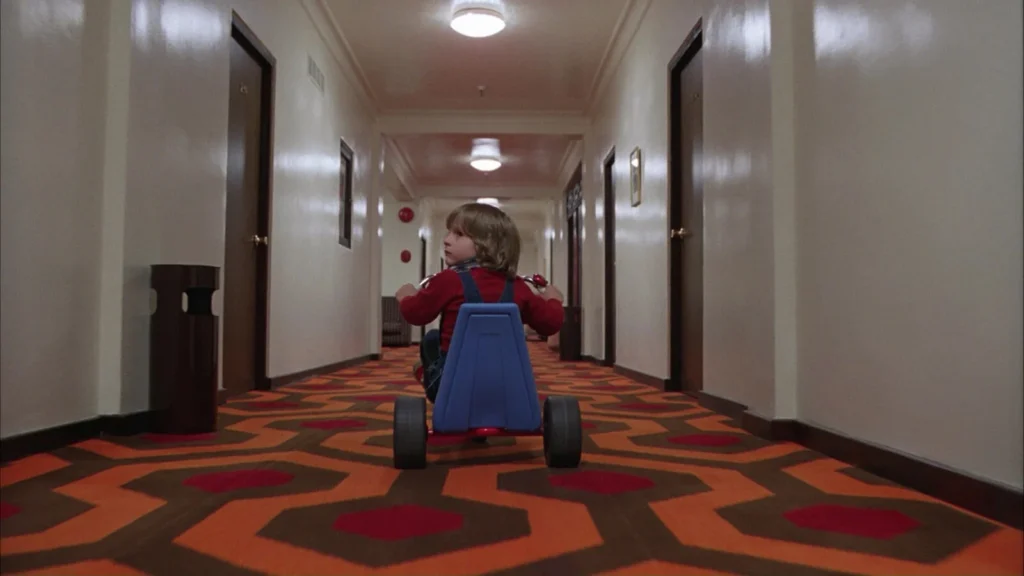
Stanley Kubrick’s The Shining (1980) is not merely a horror movie—it’s an enigmatic psychological labyrinth that continues to intrigue audiences and influence filmmakers more than four decades after its release. It’s a film that blurs the boundaries between reality and delusion, using the haunted Overlook Hotel as a pressure cooker for its characters’ deepest fears and unresolved trauma. This review explores not only its technical brilliance but also the psychological layers that make The Shining a lasting masterpiece.
Kubrick’s meticulous directorial style elevated The Shining beyond its horror roots. Known for his obsession with symmetry, long takes, and chilling minimalism, Kubrick crafted a world that feels both vast and claustrophobic. His adaptation diverges significantly from Stephen King’s novel, focusing less on overt supernatural horror and more on psychological deterioration, making the viewer question what is real and what is imagined.
Jack Torrance’s Slow Descent: The Madness Within
Jack Nicholson’s Jack Torrance is a man on the brink from the beginning. Unlike the novel’s more sympathetic character, Kubrick presents Jack as already unstable, a recovering alcoholic trying to reclaim control. The Overlook acts as both a mirror and an amplifier for Jack’s inner turmoil. The psychological terror comes not just from ghosts, but from Jack’s unravelling identity and his battle with masculinity, creative frustration, and familial resentment. His descent is gradual, methodical, and horrifying in its inevitability.
The setting itself—isolated, immense, and filled with historical atrocities—becomes a metaphor for psychological entrapment. The hotel isn’t just haunted; it becomes an extension of Jack’s mind, a symbolic space where the past continually invades the present. The repetition of patterns—both visually in the carpet and narratively in Jack’s violence—illustrates cycles of abuse and unresolved trauma that the Torrance family can’t escape.
One of the most enduring qualities of The Shining is its ambiguity. Are the ghosts real? Is Jack merely succumbing to cabin fever? Is Danny hallucinating his visions of REDRUM? Kubrick refuses to offer answers, fostering a sense of paranoia that places the audience in the same fragile mental state as the characters. This intentional ambiguity creates a uniquely personal horror experience, tailored to the fears and interpretations of each viewer.

Danny, portrayed by Danny Lloyd, is the emotional core of the film. His psychic ability, referred to as “the shining,” symbolizes heightened sensitivity to trauma and evil. More than just a plot device, Danny represents a child’s resilience and vulnerability, caught in a psychological battle far beyond his understanding. His imaginary friend, Tony, may be a dissociative coping mechanism, highlighting how children internalize and process domestic abuse.
Shelley Duvall’s Wendy: A Portrait of Psychological Erosion
Shelley Duvall’s Wendy is often misinterpreted as weak, but her performance is a raw portrayal of a woman gradually breaking under emotional and psychological abuse. Her nervous tics, high-pitched voice, and erratic behavior mirror the destabilizing effects of isolation and gaslighting. Far from passive, she fights to protect Danny, showcasing an arc of terrified determination that is as harrowing as Jack’s spiral into madness.
The infamous Room 237 scene encapsulates The Shining’s themes of seduction and revulsion. Jack’s encounter with the beautiful woman who transforms into a decaying corpse suggests a fear of aging, disease, and suppressed sexual guilt. Critics have interpreted this sequence as a metaphor for Jack’s fractured psyche, and some psychoanalytic readings link it to unresolved Oedipal tensions and the fear of female sexuality.
Kubrick and production designer Roy Walker crafted the Overlook Hotel with deliberate inconsistencies—windows where there should be none, hallways that don’t make architectural sense. This spatial disorientation creates a subconscious unease in the viewer, echoing the psychological disintegration of the characters. The hotel seems to shift and rearrange itself, just like Jack’s deteriorating perception of reality.
Mirrors play a critical symbolic role throughout The Shining, reflecting altered states of consciousness and duality. Jack sees himself in mirrors before committing violent acts, and Danny’s REDRUM is only readable when reversed. These moments suggest the characters are confronting versions of themselves they can’t control—projections of guilt, rage, and fear.
Kubrick subtly integrates themes of historical violence, particularly through the suggestion that the Overlook was built on Native American burial grounds. The ballroom ghosts, Prohibition-era imagery, and Grady’s references to “correcting” his family point to America’s buried history of violence, control, and repression. The horror of The Shining is not just personal—it’s collective, inherited, and cultural.
The film’s cryptic final shot—a 1921 photo with Jack among the partygoers—adds another layer of psychological complexity. Is Jack a reincarnation, or has he always been part of the hotel? The image destabilizes our understanding of linear time and identity, suggesting an eternal return to violence, madness, and entrapment.
Sound and Silence: The Audio Language of Terror
The unsettling score by Wendy Carlos and Rachel Elkind, combined with Penderecki’s atonal compositions, plays with dissonance and abrupt silence to provoke unease. Silence is weaponized, forcing the viewer into hyper-awareness, while sudden stings accentuate psychological ruptures. This use of sound fosters a deep, instinctual fear response in the viewer.
The Shining’s legacy is undeniable. From Ari Aster’s Hereditary to Mike Flanagan’s Doctor Sleep, the film’s DNA runs through modern horror cinema. Its focus on mood, psychology, and subtext paved the way for the genre’s evolution beyond slasher tropes. Cultural references—from The Simpsons to Ready Player One—affirm its mythic status.
The Shining endures because it reflects more than ghosts—it reflects us. Our fears of failure, loss of identity, domestic violence, and madness are magnified in its icy halls. It’s a horror film that doesn’t just aim to scare but to haunt, inviting repeated viewings and endless interpretation. In the echoing corridors of the Overlook Hotel, the real terror is not the supernatural—it’s the human mind itself.
The Shining is streaming on Max.
Read more:
For more exciting film and TV updates, check out this guide on the Top 10 Must-Watch Movies of March 2025: Freaks and Films – Ultimate Guide.